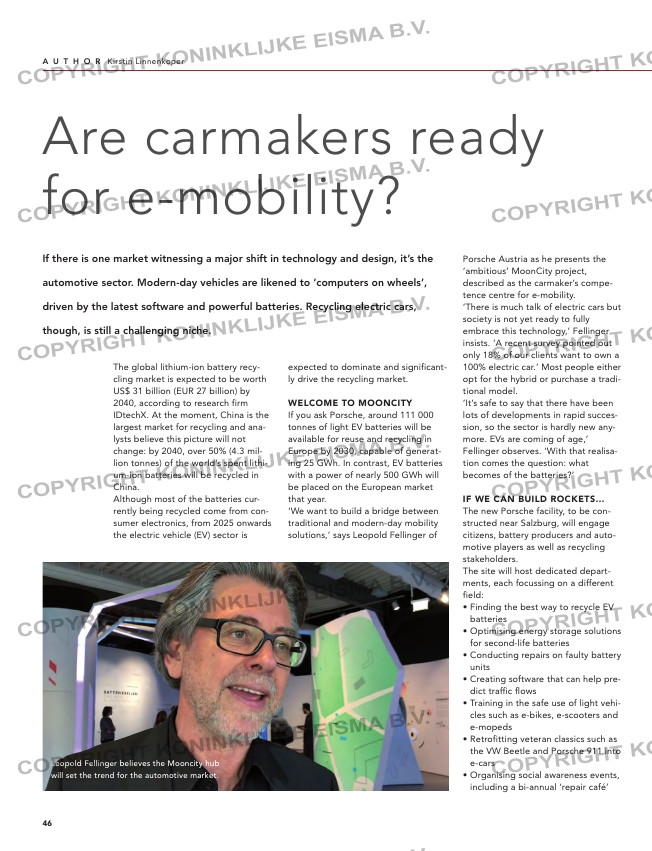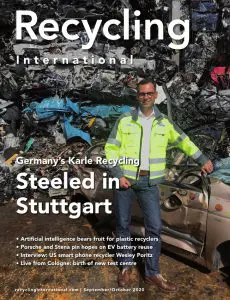Page 46 from: New issue out now!

46
Are carmakers ready
for e-mobility?
If there is one market witnessing a major shift in technology and design, it’s the
automotive sector. Modern-day vehicles are likened to ‘computers on wheels’,
driven by the latest software and powerful batteries. Recycling electric cars,
though, is still a challenging niche.
that promotes recycling to locals
and offers workshops for children
and students
‘We want to set the trend of sustain-
ability for the entire automotive sec-
tor,’ Fellinger says. ‘We want to help
develop new technologies that boost
assembly, disassembly and recycling.
And to showcase what current tech-
nologies can already do. We want to
foster networking and to make ideas
about a more sustainable, cleaner
world a reality.
‘We’ve celebrated so many milestones
in the past. We can build rockets. We
have been to the moon – that was the
inspiration behind our new facility, you
know. If we can manage that, we can
do so much more. Who knows what
tomorrow brings?’
Tesla unveils diversified
caThode
Discussions about innovation in bat-
tery chemistry and composition are
not new in the world of car recycling.
Indeed, entrepreneur Elon Musk has
just announced that manganese will
comprise one-third of the next gener-
ation EV batteries for his Tesla cars.
Speaking about future trends at his
company’s ‘Battery day 2020’, he
pointed out that having a ‘diversified’
battery cathode of two-thirds nickel
and one-third manganese cathode
would allow Tesla to make 50% more
cell volume with the same amount of
nickel. This would also open up new
opportunities for medium and long-
range vehicles.
According to Musk, Tesla will source
the manganese from local suppliers to
keep costs ‘manageable’. He is cur-
rently in talks with Euro Manganese to
provide the metal from waste, mostly
from worked-out mines, rather than
mining for fresh ore.
Meanwhile, Tesla is building a so-
called ‘giga-factory’ in Germany, which
is said to be the most advanced high-
volume EV production plant in the
world. The Berlin facility will be able to
produce 500 000 units per year, start-
ing in the summer of 2021. Musk also
announced a range of lower-cost cars
to broaden the customer base.
EV sales in China in July grew for the
The global lithium-ion battery recy-
cling market is expected to be worth
US$ 31 billion (EUR 27 billion) by
2040, according to research firm
IDtechX. At the moment, China is the
largest market for recycling and ana-
lysts believe this picture will not
change: by 2040, over 50% (4.3 mil-
lion tonnes) of the world’s spent lithi-
um-ion batteries will be recycled in
China.
Although most of the batteries cur-
rently being recycled come from con-
sumer electronics, from 2025 onwards
the electric vehicle (EV) sector is
expected to dominate and significant-
ly drive the recycling market.
Welcome To moonciTy
If you ask Porsche, around 111 000
tonnes of light EV batteries will be
available for reuse and recycling in
Europe by 2030, capable of generat-
ing 25 GWh. In contrast, EV batteries
with a power of nearly 500 GWh will
be placed on the European market
that year.
‘We want to build a bridge between
traditional and modern-day mobility
solutions,’ says Leopold Fellinger of
Porsche Austria as he presents the
‘ambitious’ MoonCity project,
described as the carmaker’s compe-
tence centre for e-mobility.
‘There is much talk of electric cars but
society is not yet ready to fully
embrace this technology,’ Fellinger
insists. ‘A recent survey pointed out
only 18% of our clients want to own a
100% electric car.’ Most people either
opt for the hybrid or purchase a tradi-
tional model.
‘It’s safe to say that there have been
lots of developments in rapid succes-
sion, so the sector is hardly new any-
more. EVs are coming of age,’
Fellinger observes. ‘With that realisa-
tion comes the question: what
becomes of the batteries?’
if We can build rockeTs…
The new Porsche facility, to be con-
structed near Salzburg, will engage
citizens, battery producers and auto-
motive players as well as recycling
stakeholders.
The site will host dedicated depart-
ments, each focussing on a different
field:
• Finding the best way to recycle EV
batteries
• Optimising energy storage solutions
for second-life batteries
• Conducting repairs on faulty battery
units
• Creating software that can help pre-
dict traffic flows
• Training in the safe use of light vehi-
cles such as e-bikes, e-scooters and
e-mopeds
• Retrofitting veteran classics such as
the VW Beetle and Porsche 911 into
e-cars
• Organising social awareness events,
including a bi-annual ‘repair café’
a u t h o R Kirstin Linnenkoper
Leopold Fellinger believes the Mooncity hub
will set the trend for the automotive market.
46-47_batteryrecyclingsolution.indd 46 29-09-20 08:45



